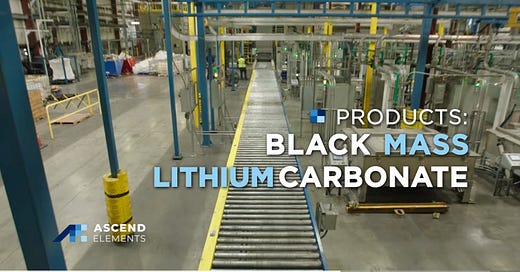In a previous article, I mentioned that Ascend Elements seems to have pivoted to an early stage lithium recovery (ESLR), a technique that is gaining widespread interest and adoption among companies engaged in the initial stage of lithium-ion battery recycling—mechanical disassembly and separation. Before this shift, Ascend Elements was using a platform that incorporated low-pressure/vacuum drying combined with a condenser to evaporate the electrolyte and deposit the lithium from it onto the granulated battery material created during shredding. This also allowed for the recovery and distillation of the solvents comprising the electrolyte, which could then be sold back to cell manufacturers.
While ESLR could be accomplished with the current mechanical platform Ascend Elements had publicly disclosed, it seemed rather inefficient and redundant for them to continue using the electrolyte recovery portion of the platform. With pyrolysis, the heat decomposes (breaks down into component elements or simpler constituents) the electrolyte, negating the need for a vacuum distillation dryer. They could roast the black mass after the electrolyte recovery stage, but the pyrolysis would allow them to recover the lithium in it anyway, and the energy requirements for both would surely eat into whatever margin the company has for the solvents from the electrolyte. Add in the thermal reduction of the cathode metals, and the continued use of the vacuum distillation dryer component of the platform becomes even more illogical.
It wasn’t until I stumbled upon the court documents outlining a lawsuit filed at the end of 2023 by a company considered the originator of low-environmental-impact lithium-ion battery recycling in Europe that Ascend Elements’ transition away from their current recycling platform—less than a year after the grand opening of their Covington plant—to a thermal reduction process that includes ESLR started to make sense.





